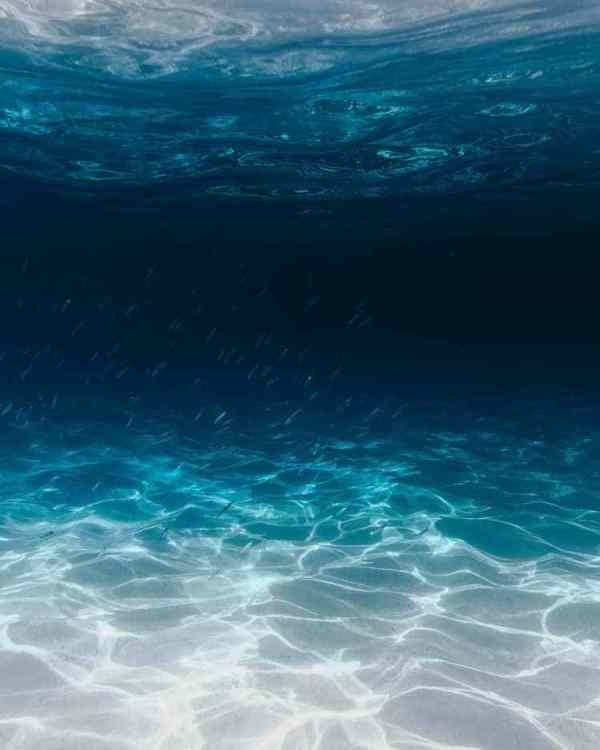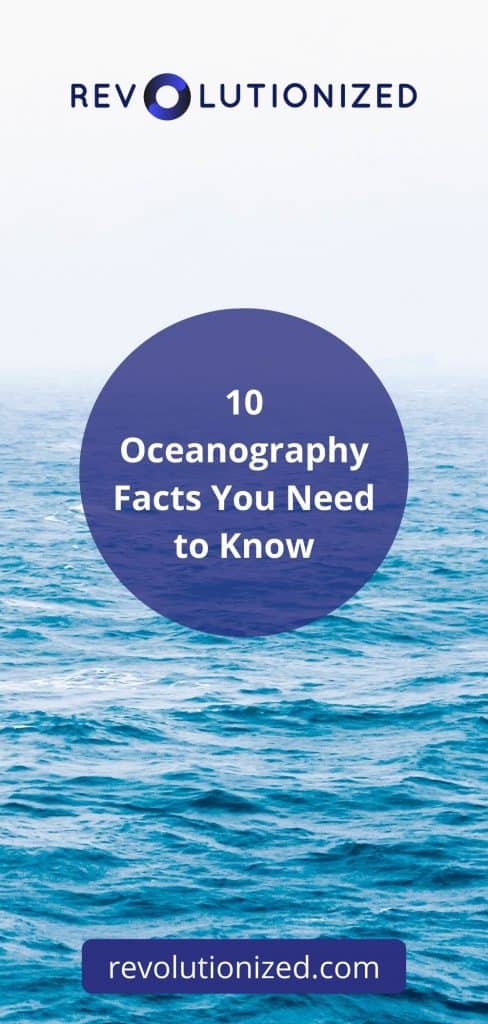
10 Oceanography Facts You Need to Know
October 29, 2021 - Emily Newton
Revolutionized is reader-supported. When you buy through links on our site, we may earn an affiliate commision. Learn more here.
Oceanographers, scientists who study the ocean, research a broad range of topics that cover just about everything there is to know about the sea. The field includes different branches. Biological oceanography studies ocean life and biology. Physical oceanography examines physical processes, like the transportation of sand by currents or the movement of water. There are many others, as well.
All these branches come together to study the ocean’s many vast and biologically diverse ecosystems and geological features. Because of oceanography, we know a lot of amazing facts about our oceans. Here are 10 of some of the most interesting oceanography facts that anyone should know.
1. Most Aquatic Life Remains Unidentified
Despite decades of intensive research, most aquatic life remains mostly unknown to science. An estimated two-thirds are still unidentified.
The ocean constitutes around 90% of the habitable space on the planet, according to UNESCO.
While there’s still a lot to learn, scientists are making significant progress. There have been major discoveries in the past few years — like the first few sightings of a live giant squid.
Researchers also recently discovered a new translucent fish species after originally confusing it with a previously identified type that looked similar.
This is just one example of why people can expect to learn new interesting facts about oceanography for their lifetimes. The mysteries of the world’s waters keep scientists motivated and help everyone else stay curious.
2. Much of the Ocean Floor Remains Unmapped
Around 80-85% of the ocean’s floor is still unmapped. The ocean floor isn’t totally unknown to scientists. Most of it has been scanned at a low resolution that gives us a rough idea of what it looks like. However, our view is about as clear as that of a planet like Mars or Venus.
Just 0.05 percent of the ocean floor has been mapped to the highest possible level of detail that sonar can capture.
That could change, though, due to the increasing interest in using ocean-mapping robots. Bedrock Ocean Exploration is one such startup taking that approach. It raised $8 million during a 2021 seed round.
3. There Are Incredible Mountains, Rivers and Waterfalls Beneath the Ocean Surface
Much of what we do know about the ocean floor, however, is pretty spectacular.
Like the other scientists who study the Earth, oceanographers discovered some incredible information about the physical structure of the land beneath the oceans. The geography and geology of the ocean floor is highly diverse, and home to breathtaking physical features. There are mysterious deep-sea rivers, the world’s largest waterfall and the longest mountain range in the world, the mid-ocean ridge.
As researchers examined Spain’s Canal de Mallorca undersea mountains recently, they found three new sponge species. The team also identified three other types of sponges previously not known to live in the Mediterranean region.
You may have also heard of some of the other features that exist in the ocean depths, like the Marianas Trench. It contains the lowest points known to exist on Earth.
4. Manned Submersibles Could Make the Deep Sea More Accessible
Some oceanography facts can be quite eye-opening, especially when they relate to the particularly hard-to-reach places. A large part of why much of the ocean is still unmapped is that it’s very hard to reach its depths.
Work carried out by Chinese scientists may change that soon, though. They’re testing a manned submersible capable of getting to deep-sea locations. That approach could enable new types of oceanography performed safely.
In 2021, they used it to pull a batch of viruses from the deepest part of the Mariana Trench and identify them. The location, which was nearly 36,000 feet below sea level, was home to several giant viral species. Researchers had found them elsewhere, but this team said the viruses seemed more abundant at these greater depths.
5. The Oceans May Contain More Historical Artifacts Than The World’s Museums Combined
Over centuries, shipwrecks, changing tides and floods led to losing history to the depths of the ocean. Now, it’s normal for scientists to regularly find historical artifacts resting at the bottom of the sea or washed up on shore.
It’s hard to know how many artifacts are at the bottom of the sea. Archaeologists believe there could easily be more history lost to the oceans than what is preserved in all the world’s museums.
One recent discovery in the Baltic Sea was a wrecked ship that sank in the summer of 1495 and once belonged to a Danish king. Researchers are eager to examine it more closely, due in part to how sources say the medieval-era royal typically traveled with lots of possessions.
They also believe the items could be especially well-preserved. That’s because an organism called the shipworm typically eats away any such wreckage not covered by sediment. However, it cannot survive in the Baltic Sea.

6. The Oceans Are Full of Gold
There are other treasures in the sea beyond historical artifacts — the waters of the ocean are also full of gold. According to NOAA, there are more than 20 million pounds of gold suspended in ocean water. For comparison, there are around 147 million troy ounces, or about 10.7 million pounds, of gold in Fort Knox.
However, this gold is distributed throughout the entire ocean. Therefore, the concentration of gold is somewhere in the range of a few parts per trillion for each liter of seawater.
It’s not always the most-experienced divers and oceanographers who strike gold, though. In an exciting discovery that made headlines in September 2021, two brothers found gold coins while snorkelling in Spain.
They came across eight pieces dating back 1,500 years. Later investigations linked the money to the Roman Empire. After the pair reported their amazing find to authorities, scientists located more than 50 coins which were well-preserved enough to easily identify the figures etched into them.
7. The Ocean Contains the World’s Largest Living Structure
The Great Barrier Reef, a coral reef system made up of more than 2,900 individual reefs, is the world’s largest living structure. At a little more than 1,400 miles, it’s both longer than any other coral reef system or living structure on the planet.
The reef is also home to a huge number of different species, and is likely as biodiverse as the rainforests. However, like the rainforests, it’s also threatened by climate change. Rising ocean acidity caused by CO2 threatens to kill off significant amounts of the reef unless action is taken.
However, preservation remains among the most-discussed oceanography topics of current times. One effort from Australian scientists involves using a mist machine to brighten clouds and block sunlight. The device had 320 nozzles spraying microdroplets at the sky above the famous coral reef.
Some of the other possibilities include breeding heat-resistant varieties of coral and dumping crushed rocks in the affected area as a countermeasure against the acidification problem.
8. Deep Ocean Water Temperature Varies Massively
In general, water at the bottom of the ocean is very, very cold — around 32 to 37 degrees Fahrenheit. Cold water is heavier than warm water and tends to sink as low as it can go. However, not all the water at the bottom of the ocean is so frigid. Hydrothermal vents, located at the bottom of the sea, can release seawater that is boiling hot — reaching temperatures as high as 700 degrees Fahrenheit.
Ongoing studies could eventually alter well-established oceanography facts about deep ocean water temperatures, though. An intensive study across long periods shows that temperatures are rising at levels scientists deem significant, though not as rapidly as climate change has affected land temperatures.
9. Most of the Oxygen We Breathe Comes From the Ocean
By most estimates, the ocean produces around 70% of the oxygen we breathe — mostly from phytoplankton, a type of marine organism.
In addition to this, phytoplankton also provide the foundation for most ocean ecosystems by filling out the base of the food chain.
However, scientists are keeping an eye on some areas with low oxygen levels in their waters. They say the matter is likely another climate change complication but still need to investigate further to learn more about what’s happening.
The New England region is one of the areas attracting attention. Researchers say this low-oxygen issue has not occurred there before.
10. The Oceans Are the Planet’s Biggest Carbon Sinks
The ocean naturally pulls huge amounts of carbon dioxide out of the atmosphere. Right now, scientists estimate that one-third of all carbon dioxide put into the atmosphere by human activities has been absorbed by the oceans.
However, this absorption of carbon dioxide is starting to cause problems for ocean life. Increased acidification, driven by heightened water CO2 levels, is harming major ocean ecosystems like the Great Barrier Reef. Rising CO2 levels can also lead to algal blooms — rapid growth in the phytoplanktons that pull in much of the atmosphere’s CO2. This can cause serious problems for local ecosystems and ocean life.
In 2021, new research indicated the ocean might eventually stop absorbing carbon dioxide or even start emitting it. They cautioned that it’s still too early to know what the effects of such a change might be, but these possibilities need additional study.
What These Oceanography Facts Can Teach Us
Thanks to oceanographers, we know a lot more about our oceans than we would otherwise. Still, much about the sea remains unknown. More discoveries await for adventurous scientists willing to travel to the depths.
This article was originally published on March 10, 2020 and was updated October 29, 2021 to provide readers with more updated information.
Revolutionized is reader-supported. When you buy through links on our site, we may earn an affiliate commision. Learn more here.
Author
Emily Newton
Emily Newton is a technology and industrial journalist and the Editor in Chief of Revolutionized. She manages the sites publishing schedule, SEO optimization and content strategy. Emily enjoys writing and researching articles about how technology is changing every industry. When she isn't working, Emily enjoys playing video games or curling up with a good book.




